Search Thermo Fisher Scientific
Invitrogen
Gnb1 Polyclonal Antibody
This Antibody was verified by Knockout to ensure that the antibody binds to the antigen stated.
FIGURE: 1 / 5
Gnb1 Antibody (PA1-725) in WB
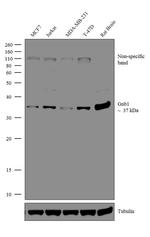
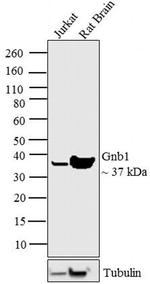
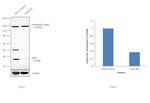
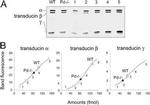
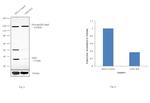
Product Details
PA1-725
Species Reactivity
Published species
Host/Isotype
Class
Type
Immunogen
Conjugate
Form
Concentration
Purification
Storage buffer
Contains
Storage conditions
Shipping conditions
RRID
Product Specific Information
PA1-725 detects transducin beta (T beta) from sheep, bovine, mouse and drosophila.
PA1-725 has been successfully used in Western blot procedures. By Western blot, this antibody detects an ~37 kDa protein representing Tr beta from sheep and bovine retinal and optic nerve extracts as well as mouse eye samples and drosophila.
The PA1-725 immunizing peptide corresponds to amino acid residues 8-25 from human Tr beta. This sequence is completely conserved between human, amphibian, bovine and rat. PA1-725 immunizing peptide (Cat. # PEP-154) is available for use in neutralization and control experiments.
Target Information
Vision involves the conversion of light into electrochemical signals that are processed by the retina and subsequently sent to and interpreted by the brain. The process of converting light into an electrochemical signal begins when the membrane-bound protein, rhodopsin, absorbs light within the retina. Photoexcitation of rhodopsin causes the cytoplasmic surface of the protein to become catalytically active. In the active state, rhodopsin activates transducin, a GTP binding protein. Once activated, transducin promotes the hydrolysis of cGMP by phosphodiesterase (PDE). The decrease of intracellular cGMP concentration causes the ion channels within the outer segment of the rod or cone to close, thus causing membrane hyperpolarization and, eventually, signal transmission. Rhodopsin activity is believed to be shut off by phosphorylation followed by binding of the soluble protein, arrestin. Transducin, once activated by rhodopsin, promotes the hydrolysis of cGMP by PDE. The subunit composition of transducin differs between different photoreceptor cells. Rod transducin consists of rod transducin alpha (Tr alpha), T beta, and T gamma. Cone transducin is composed of cone transducin alpha (Tc alpha), T beta and T gamma. Differential transducin subunit composition of transducin is believed to be responsible for the different light sensitivities between photoreceptive cells.
For Research Use Only. Not for use in diagnostic procedures. Not for resale without express authorization.
Bioinformatics
Protein Aliases: beta subunit, signal-transducing proteins GS/GI; gbb1; guanine nucleotide binding protein (G protein), beta 1; guanine nucleotide binding protein (G protein), beta polypeptide 1; guanine nucleotide binding protein, beta 1; Guanine nucleotide-binding protein beta 1; Guanine nucleotide-binding protein G(I)/G(S)/G(T) subunit beta-1; guanine nucleotide-binding protein, beta-1 subunit; T beta; testicular tissue protein Li 72; Transducin beta chain 1; transducin beta subunit; unnamed protein product
Gene Aliases: AA409223; C77571; Gnb-1; GNB1; MRD42
UniProt ID: (Bovine) P62871, (Human) P62873, (Mouse) P62874, (Rat) P54311
Entrez Gene ID: (Bovine) 281201, (Sheep) 101104166, (Human) 2782, (Mouse) 14688, (Rat) 24400

Performance Guarantee
If an Invitrogen™ antibody doesn't perform as described on our website or datasheet,we'll replace the product at no cost to you, or provide you with a credit for a future purchase.*
Learn more
We're here to help
Get expert recommendations for common problems or connect directly with an on staff expert for technical assistance related to applications, equipment and general product use.
Contact tech support
